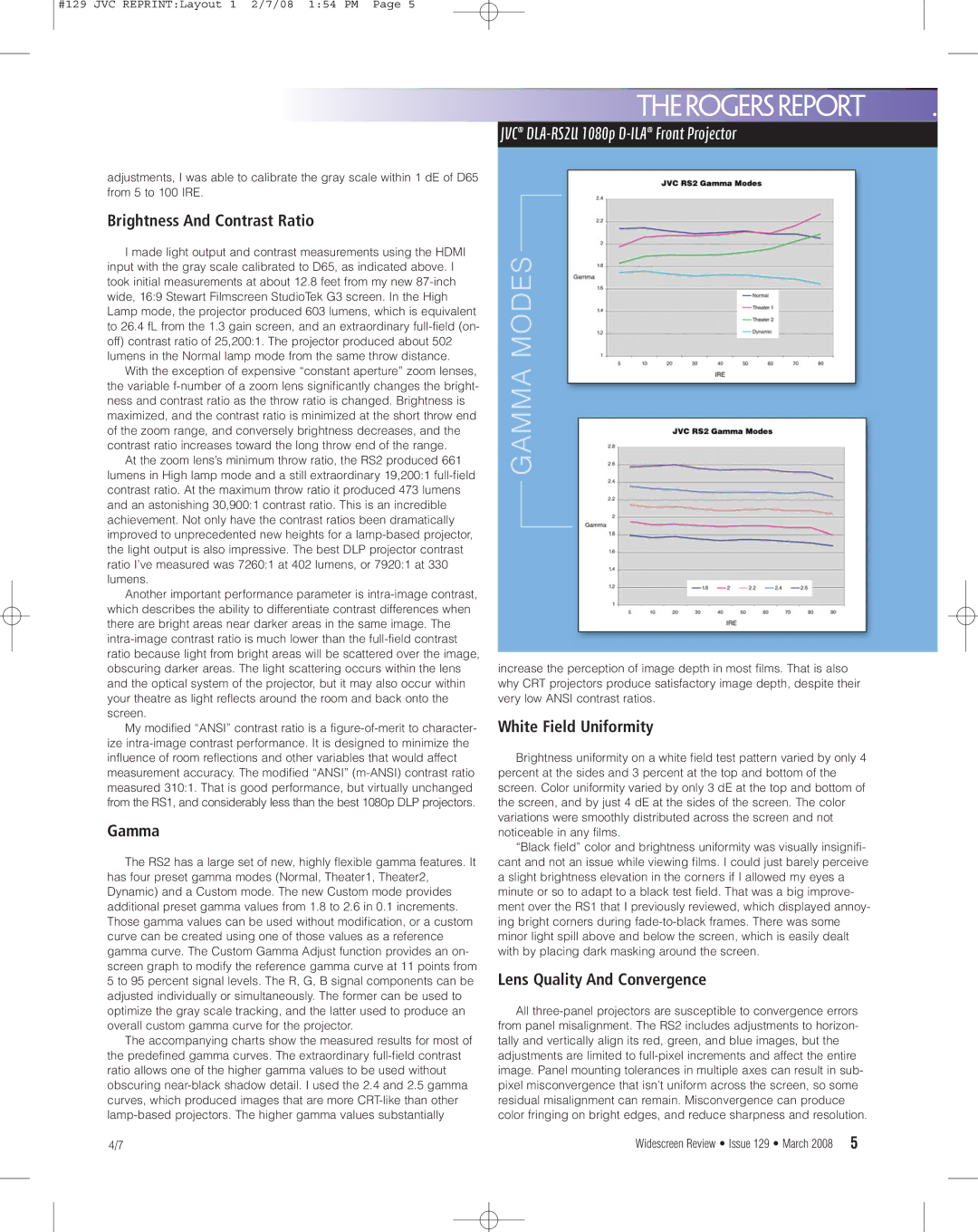adjustments, I was able to calibrate the gray scale within 1 dE of D65 from 5 to 100 IRE.
Brightness And Contrast Ratio
I made light output and contrast measurements using the HDMI input with the gray scale calibrated to D65, as indicated above. I took initial measurements at about 12.8 feet from my new 87-inch wide, 16:9 Stewart Filmscreen StudioTek G3 screen. In the High Lamp mode, the projector produced 603 lumens, which is equivalent to 26.4 fL from the 1.3 gain screen, and an extraordinary full-field (on- off) contrast ratio of 25,200:1. The projector produced about 502 lumens in the Normal lamp mode from the same throw distance.
With the exception of expensive “constant aperture” zoom lenses, the variable f-number of a zoom lens significantly changes the bright- ness and contrast ratio as the throw ratio is changed. Brightness is maximized, and the contrast ratio is minimized at the short throw end of the zoom range, and conversely brightness decreases, and the contrast ratio increases toward the long throw end of the range.
At the zoom lens’s minimum throw ratio, the RS2 produced 661 lumens in High lamp mode and a still extraordinary 19,200:1 full-field contrast ratio. At the maximum throw ratio it produced 473 lumens and an astonishing 30,900:1 contrast ratio. This is an incredible achievement. Not only have the contrast ratios been dramatically improved to unprecedented new heights for a lamp-based projector, the light output is also impressive. The best DLP projector contrast ratio I’ve measured was 7260:1 at 402 lumens, or 7920:1 at 330 lumens.
Another important performance parameter is intra-image contrast, which describes the ability to differentiate contrast differences when there are bright areas near darker areas in the same image. The intra-image contrast ratio is much lower than the full-field contrast ratio because light from bright areas will be scattered over the image, obscuring darker areas. The light scattering occurs within the lens and the optical system of the projector, but it may also occur within your theatre as light reflects around the room and back onto the screen.
My modified “ANSI” contrast ratio is a figure-of-merit to character- ize intra-image contrast performance. It is designed to minimize the influence of room reflections and other variables that would affect measurement accuracy. The modified “ANSI” (m-ANSI) contrast ratio measured 310:1. That is good performance, but virtually unchanged from the RS1, and considerably less than the best 1080p DLP projectors.
Gamma
The RS2 has a large set of new, highly flexible gamma features. It has four preset gamma modes (Normal, Theater1, Theater2, Dynamic) and a Custom mode. The new Custom mode provides additional preset gamma values from 1.8 to 2.6 in 0.1 increments. Those gamma values can be used without modification, or a custom curve can be created using one of those values as a reference gamma curve. The Custom Gamma Adjust function provides an on- screen graph to modify the reference gamma curve at 11 points from 5 to 95 percent signal levels. The R, G, B signal components can be adjusted individually or simultaneously. The former can be used to optimize the gray scale tracking, and the latter used to produce an overall custom gamma curve for the projector.
The accompanying charts show the measured results for most of the predefined gamma curves. The extraordinary full-field contrast ratio allows one of the higher gamma values to be used without obscuring near-black shadow detail. I used the 2.4 and 2.5 gamma curves, which produced images that are more CRT-like than other lamp-based projectors. The higher gamma values substantially
4/7
THEROGERSREPORT .
JVC® DLA-RS2U 1080p D-ILA® Front Projector
GAMMA MODES
increase the perception of image depth in most films. That is also why CRT projectors produce satisfactory image depth, despite their very low ANSI contrast ratios.
White Field Uniformity
Brightness uniformity on a white field test pattern varied by only 4 percent at the sides and 3 percent at the top and bottom of the screen. Color uniformity varied by only 3 dE at the top and bottom of the screen, and by just 4 dE at the sides of the screen. The color variations were smoothly distributed across the screen and not noticeable in any films.
“Black field” color and brightness uniformity was visually insignifi- cant and not an issue while viewing films. I could just barely perceive a slight brightness elevation in the corners if I allowed my eyes a minute or so to adapt to a black test field. That was a big improve- ment over the RS1 that I previously reviewed, which displayed annoy- ing bright corners during fade-to-black frames. There was some minor light spill above and below the screen, which is easily dealt with by placing dark masking around the screen.
Lens Quality And Convergence
All three-panel projectors are susceptible to convergence errors from panel misalignment. The RS2 includes adjustments to horizon- tally and vertically align its red, green, and blue images, but the adjustments are limited to full-pixel increments and affect the entire image. Panel mounting tolerances in multiple axes can result in sub- pixel misconvergence that isn’t uniform across the screen, so some residual misalignment can remain. Misconvergence can produce color fringing on bright edges, and reduce sharpness and resolution.
Widescreen Review • Issue 129 • March 2008 | 5 |

